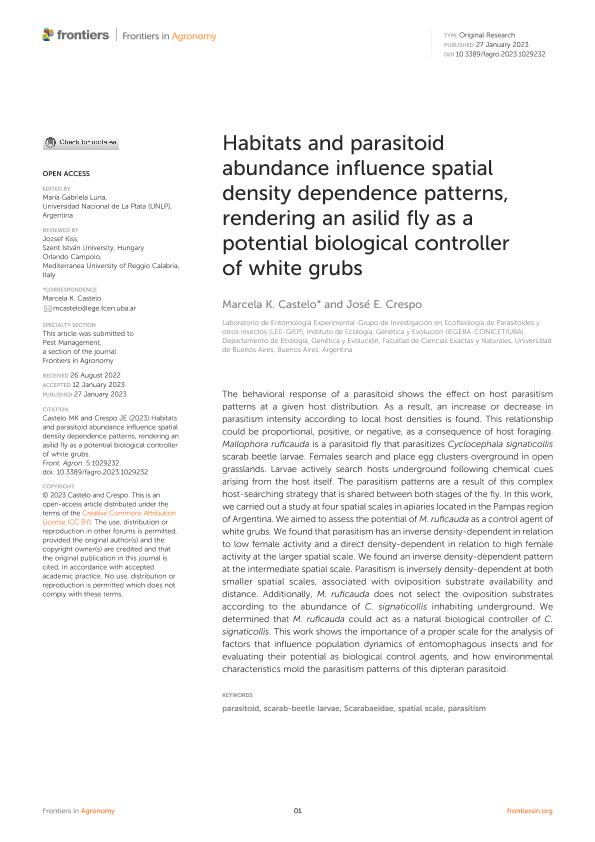Artículo
Habitats and parasitoid abundance influence spatial density dependence patterns, rendering an asilid fly as a potential biological controller of white grubs
Fecha de publicación:
01/2023
Editorial:
Frontiers Media
Revista:
Frontiers in Agronomy
ISSN:
2673-3218
Idioma:
Inglés
Tipo de recurso:
Artículo publicado
Clasificación temática:
Resumen
The behavioral response of a parasitoid shows the effect on host parasitism patterns at a given host distribution. As a result, an increase or decrease in parasitism intensity according to local host densities is found. This relationship could be proportional, positive, or negative, as a consequence of host foraging. Mallophora ruficauda is a parasitoid fly that parasitizes Cyclocephala signaticollis scarab beetle larvae. Females search and place egg clusters overground in open grasslands. Larvae actively search hosts underground following chemical cues arising from the host itself. The parasitism patterns are a result of this complex host-searching strategy that is shared between both stages of the fly. In this work, we carried out a study at four spatial scales in apiaries located in the Pampas region of Argentina. We aimed to assess the potential of M. ruficauda as a control agent of white grubs. We found that parasitism has an inverse density-dependent in relation to low female activity and a direct density-dependent in relation to high female activity at the larger spatial scale. We found an inverse density-dependent pattern at the intermediate spatial scale. Parasitism is inversely density-dependent at both smaller spatial scales, associated with oviposition substrate availability and distance. Additionally, M. ruficauda does not select the oviposition substrates according to the abundance of C. signaticollis inhabiting underground. We determined that M. ruficauda could act as a natural biological controller of C. signaticollis. This work shows the importance of a proper scale for the analysis of factors that influence population dynamics of entomophagous insects and for evaluating their potential as biological control agents, and how environmental characteristics mold the parasitism patterns of this dipteran parasitoid.
Palabras clave:
PARASITISM
,
PARASITOID
,
SCARAB-BEETLE LARVAE
,
SCARABAEIDAE
,
SPATIAL SCALE
Archivos asociados
Licencia
Identificadores
Colecciones
Articulos(IEGEBA)
Articulos de INSTITUTO DE ECOLOGIA, GENETICA Y EVOLUCION DE BS. AS
Articulos de INSTITUTO DE ECOLOGIA, GENETICA Y EVOLUCION DE BS. AS
Articulos(OCA CIUDAD UNIVERSITARIA)
Articulos de OFICINA DE COORDINACION ADMINISTRATIVA CIUDAD UNIVERSITARIA
Articulos de OFICINA DE COORDINACION ADMINISTRATIVA CIUDAD UNIVERSITARIA
Citación
Castelo, Marcela Karina; Crespo, José Emilio; Habitats and parasitoid abundance influence spatial density dependence patterns, rendering an asilid fly as a potential biological controller of white grubs; Frontiers Media; Frontiers in Agronomy; 5; 1-2023; 1-11
Compartir
Altmétricas




